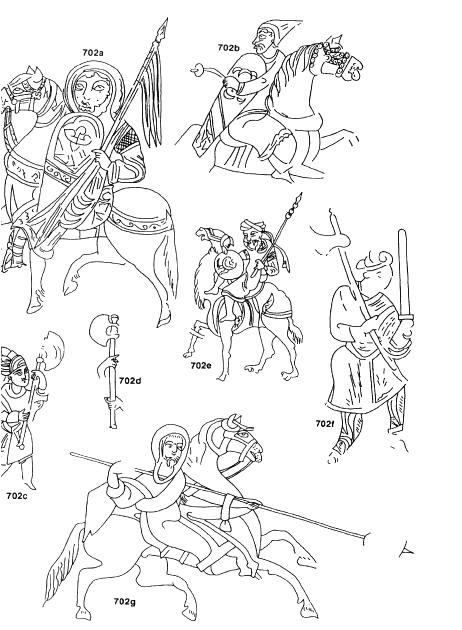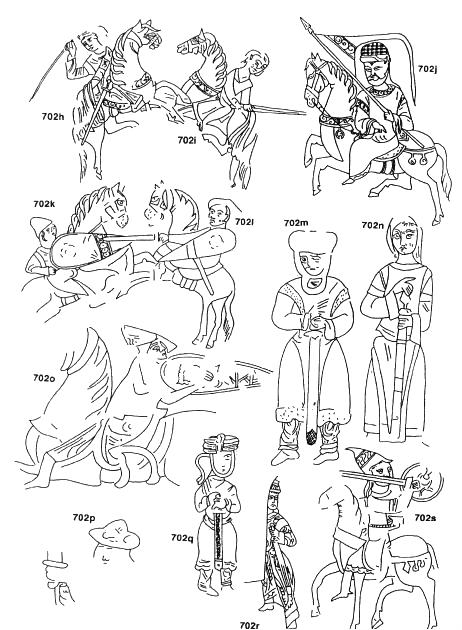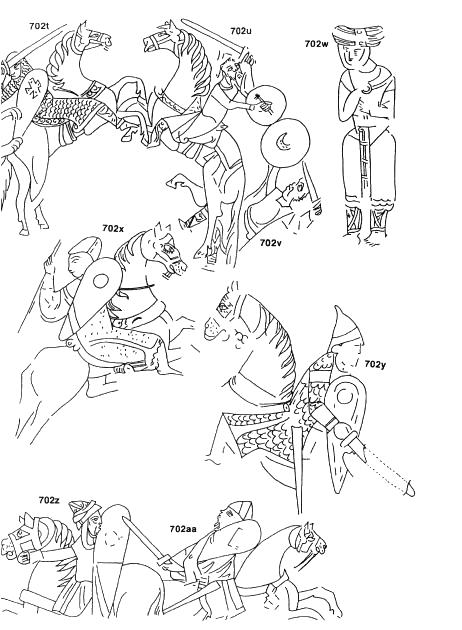Create an Amazon Business Account

Amazon Audible Gift Memberships
Figures from
The Painted Wooden Ceiling of the Palatine Chapel
Cappella Palatina
Palermo, Sicily
An extract from pp.264-265, Crusader Warfare Volume I: Byzantium, Western Europe and the Battle for the Holy Land by David Nicolle
702A-AA Painted wooden ceiling panels, Sicily, c.1140
(in situ Cappella Palatina, Palermo, Italy)
The Cappella Palatina ceiling is painted in Islamic early Fāṭimid style, though dating from the mid-l2th century and executed for the Christian ruler King Roger II.
Most of the military figures portrayed on the panels are dressed and equipped in western Islamic style, perhaps that of Sicilian Muslims who fought for the Norman kings.
Only one figure clearly represents a Christian warrior (T). He may be one of the new Norman aristocracy of Sicily.
Other figures are obviously Muslim or specifically Arab (E, C, F, M, P, Q, W and Z) and most wear turbans.
Some of these are worn over pointed helmets or tall caps (C, P and Z). Elsewhere, pointed headgear might be helmets or hats (B, K, S, Y and AA) but are probably the former.
Only one helmet clearly has a broad nasal (O) although others may do so (S and Y).
Round helmets are present but are less common (J, T and X).
Body armour, in common with the military fashions of most Islamic areas outside Iran and al-Andalus, is rarely seen but was presumably worn, by some warriors beneath other clothes.
Those that are visible are worn by horsemen and consist of mid-length or long-sleeved mail hauberks with or without coifs (T, X and Y).
Shields are as varied as one would expect in such a culturally mixed area as Norman Sicily. With one exception they are all carried by horsemen.
An example of a flat-based kite-shaped januwiyah (B)
should still be regarded as an infantry shield although it has incongruously been given to a horseman or mounted infantryman.
Other shields include small round buckers (E, S, U, and V) and normal 12th-century kite-shaped shields (A, K, L, O, T, X-Z and AA).
The bases of some of these shields are obscured by later restoration and may well have been flat, this making them januwiyah (Z and AA).
Two figures also use cloaks over their arms as rudimentary shields (H and I). Some weapons are easy to identify.
For example, a spear carried by a camel-riding Arab is clearly related to those used by Arab Bedouin in an early 13th century Maqamat manuscript.
Some of the others have the fanciful or at least more complicated blades which are similarly seen in the Middle East (A, J and X).
There might be a problem of interpretation with some objects having half moon apparent blades attached to them (C and D).
These could be the nāchakh axes of a ruler's Úlite guard or could simply be light fans to cool the ruler's brow.
One other long-hafted axe (F) has an unmistakably upwards-sweeping blade and as such is a typically north European weapon descended from the 11th century 'Danish axe'.
Its appearance in Palermo is interesting and might suggest the presence of Anglo-Norman infantry.
Only one mace is shown, with a broken haft and in the hands of a fleeing warrior, the same man who carries a januwiyah.
Perhaps he represents a defeated infantryman who has seized a horse. Swords are by far the most common weapon on the Cappella Palatina ceiling.
Most are straight, barely tapering, with blunt or slightly pointed tips. Most have thick but short bar-like quillons.
Other variations have broad-curved quillons with a langet (M) and what could be the non-symmetrical quillons of a slightly curved weapon (Y).
Pommels are generally obscured, although that of a clearly visible, narrower-bladed weapon (H) seems to be round.
Others might also be (F, R and W) while another might be nut-shaped (P). Some blades have central ridges clearly indicated (I and S).
One of these (E) lacks quillons or guard. As such it is another example of a type of sword associated with North Africa.
A much shorter and perhaps more tapering weapon (V) that is, however, held like a sword rather than a dagger, is placed in the hands of an infantryman.
A final interesting figure holds a long-hafted object in a kind of waist sling that hangs almost to his ankles (N).
This might be a means of supporting a large banner or perhaps the ruler's ceremonial parasol although a short, pointed,
mace-headed or sword-like object seems at present to be held in the sling.
Original paintings for 702A & J from The Painted Wooden Ceiling of the Palatine Chapel, Cappella Palatina, Palermo, Sicily
Illustrations of The Painted Wooden Ceiling of the Palatine Chapel, Cappella Palatina, Palermo, Sicily
See also Illustrations of Costume and Soldiers in manuscripts of the Maqamat of al-Hariri



